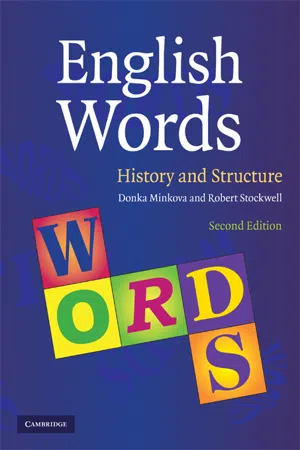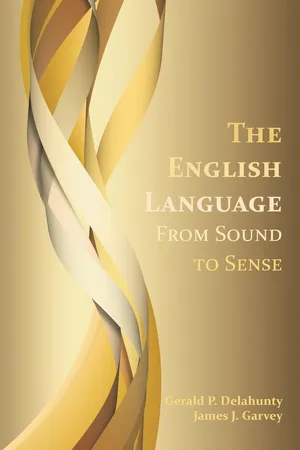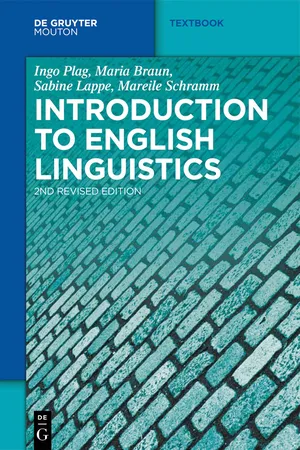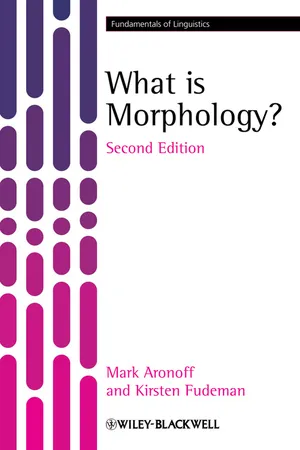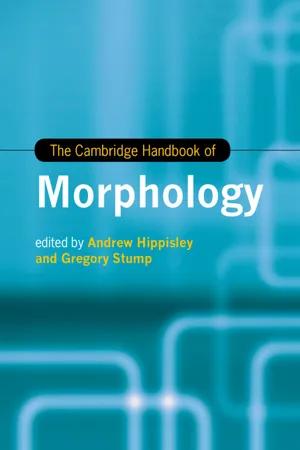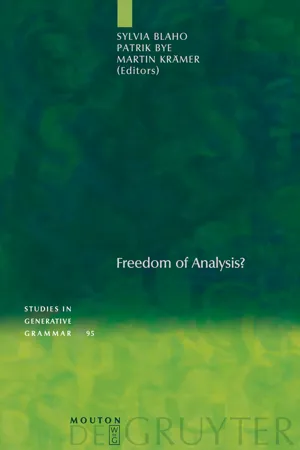Languages & Linguistics
Allomorph
An allomorph is a variant form of a morpheme, which is a unit of meaning in language. Allomorphs can differ in pronunciation or spelling but have the same meaning and function. For example, the plural morpheme in English has three allomorphs: /s/, /z/, and /ɪz/ as in cats, dogs, and horses.
Written by Perlego with AI-assistance
Related key terms
1 of 5
9 Key excerpts on "Allomorph"
- eBook - PDF
English Words
History and Structure
- Donka Minkova, Robert Stockwell(Authors)
- 2009(Publication Date)
- Cambridge University Press(Publisher)
Allomorph. You will recall (Chapter 4, Section 5) that, in principle, all Allomorphs are cognates. A question which arises in this connection is whether Allomorphic variation can produce forms 84 Allomorphy, phonetics, and affixation which are so far apart in both sound and sense that they are no longer recognizable Allomorphs. There comes a point, admittedly not easily defined, when some members of a word-family become unrecognizable as variants of a single mor- pheme. For the modern speakers, even for many highly sophisticated and well-educated speakers, such Allomorphy is completely dead, or at least fossilized. In the same way that fossils tell us the story of earlier geological times, fossilized variants of a single morpheme take us back to earlier layers of linguistic history. If we go into considerable time-depth, we can find cognate relationships which are not recognizable any longer: that is, forms which are no longer seen as being allo- morphs at all: √graph and √gram ‘write’ in monograph and monogram, √glot and √glos ‘tongue, speech’ in glottis and glossary , √vac, √van, √voi ‘empty’ in vacant, vanish and void, in which the etymological roots have appeared in alternate shapes for ages, but the reasons for the alternation are not recoverable. As noted above, such completely fossilized variants are simply cognates, not Allomorphs. Put dif- ferently, while all Allomorphs are cognates, not all cognates are Allomorphs in the narrower, synchronic understanding of Allomorphy . So, in spite of the fact that sets such as √ced=ceed ‘go, let go,’ √erg = urg = org ‘work’ may have been allo- morphic at some stage in history, for us they are unpredictably variable cognates. In a discussion of Allomorphy, we should also note that a large number of morphemes appear to preserve both their spelling and their pronunciation in all forms. - eBook - PDF
Phonological Explorations
Empirical, Theoretical and Diachronic Issues
- Bert Botma, Roland Noske, Bert Botma, Roland Noske(Authors)
- 2012(Publication Date)
- De Gruyter(Publisher)
In many languages, a lexical item may have various stems that are used in inflection and word formation. In Latin, for instance, verbs have three different stem Allomorphs, and the choice of a particular stem variant is determined by purely morphological considerations. In the case of Allomorphy and the architecture of grammar 17 Dutch, the choice of Allomorph may also be conditioned semantically, as shown in (9): one Allomorph, used in a particular morphological structure, carries one meaning from the set of meanings of a lexical item. We have seen, therefore, that an Allomorph which results from a historical phonological process of schwa-deletion may receive a new interpretation as an affixoid, that is, as a word with a specific meaning in a specific morpho-logical structure. 3 Morphological selection of Allomorphs The data discussed in section 2 show that the selection of Allomorphs may shift from phonology to morphology (cf. also Booij 2002, Chapter 5.3). The morphological selection of Allomorphs can also be observed in the systematic difference between native and non-native Allomorphs of Dutch words. Consider the following sets of related words: (11) Base word Native suffix Non-native suffix a. filter /f ʏ lt ԥ r/ ‘filter’ filter-en ‘to filter’ filtr-eer ‘to filter’ b. regel /re ٝ Ճ ԥ l/ ‘rule’ regel-en ‘to arrange’ regul-eer ‘to regulate’ c. orkest / Þ rk İ st/ ‘orchestra’ orkest-en ‘orchestras’ orkestr-eer ‘to orchestrate’ In (11a), the word filter has the Allomorph filtr - in words coined with a non-native suffix; in (11b), the word regel has regul - as its Allomorph before the non-native suffix -eer ; in (11c), the word orkest has the Allomorph orkestr - before the non-native suffix -eer . - eBook - PDF
- Geert E. Booij, Christian Lehmann, Joachim Mugdan, Geert E. Booij, Christian Lehmann, Joachim Mugdan(Authors)
- 2008(Publication Date)
- De Gruyter Mouton(Publisher)
2.2. Morphophonemes in the description of Allomorphy The purpose of using morphophonemes in accounting for alternations is (4) “to define elements, as constituents of morphe-mic segments, in terms of which all the segment members of a given morpheme would be iden-tical” (Harris 1951: 219); the advantage of this approach (5) “becomes apparent when we realize […] that there may be many morphemes whose mem-bers differ from each other identically.” (Har-ris 1951: 226) For instance, the English morpheme { leaf } has two Allomorphs, /li 6 f/ in leaf and /li 6 v/ in leaves , which share the first two segments, /l/ 491 50. Generalized representations and /i 6 /, and differ in the third. From a mor-phological point of view, however, the set of alternating phonemes /f/ /v/ (where the symbol stands for “alternates with”) con-stitutes a unitary element, a morphophoneme which is typically symbolized by //F//. The notational distinction between morphopho-nemes (with double slashes //…//) and pho-nemes (with single slashes /…/) reflects the different linguistic levels at which these units are posited. Because of this separation of levels, the aim stated in (4) requires an extension of the original concept of the morphophoneme (cf. also Matthews 1970: 100f. on analogous pro-posals in Stratificational Grammar): in order to achieve a single representation of { leaf } , morphophonemes must be set up even where there is no alternation between a set of pho-nemes at corresponding points in the allo-morphs of a morpheme. Thus, the first two segments in the Allomorphs /li 6 f/ and /li 6 v/ are identified as the morphophonemes //l// and //i 6 //. (Often, upper-case letters or small capi-tals are used for morphophonemes that cor-respond to an alternation and lower-case let-ters for those that do not; cf. Harris 1951: 225.) Now the morpheme { leaf } can be given a morphophonemic representation //li 6 F//, in which each symbol stands for a morphopho-neme. - eBook - PDF
English Language, The
From Sound to Sense
- Gerald P. Delahunty, James J. Garvey(Authors)
- 2010(Publication Date)
- Parlor Press, LLC(Publisher)
Does your dictionary list bound morphemes? Which kinds? MORPHEMES , AllomorphS , AND MORPHS The English plural morpheme {-s} can be expressed by three different but 125 Morphology and Word Formation clearly related phonemic forms / @ z/ or / z/, /z/, and /s/. These three have in common not only their meaning, but also the fact that each contains an alveolar fricative phoneme, either /s/ or /z/. The three forms are in comple-mentary distribution, because each occurs where the others cannot, and it is possible to predict just where each occurs: / I z/ after sibilants (/s, z, S , Z , t S , d Z /), /z/ after voiced segments, and /s/ everywhere else. Given the semantic and phonological similarities between the three forms and the fact that they are in complementary distribution, it is reasonable to view them as contex-tual pronunciation variants of a single entity. In parallel with phonology, we will refer to the entity of which the three are variant representations as a morpheme , and the variant forms of a given morpheme as its Allomorphs . When we wish to refer to a minimal grammatical form merely as a form, we will use the term morph . Compare these terms and the concepts behind them with phoneme, allophone, and phone. (Hint: note the use of / /, [ ], and { }.) Exercise Consult the glossary in the chapter on Phonetics and Phonology and try to determine the meanings of the morphemes {phone}, {allo-}, and {-eme}. (1) /phoneme/ [allophone] [allophone] [allophone] etc. (2) {morpheme} /Allomorph/ /Allomorph/ /Allomorph/ etc. WORDS Words are notoriously difficult entities to define, both in universal and in language specific terms. Like most linguistic entities, they look in two direc-tions—upward toward larger units of which they are parts (toward phrases), and downward toward their constituent morphemes. - eBook - PDF
- Ingo Plag, Maria Braun, Sabine Lappe, Mareile Schramm(Authors)
- 2009(Publication Date)
- De Gruyter Mouton(Publisher)
Phonologists have shown that these sounds behave similarly in many languages and have therefore assigned them to a class of their own, called sibilants . Hence, we can generalise that the Allomorph [ ´z ] occurs after sibilants. And we can draw the conclusion that, like the Allomorphs of the in- 86 The structure of words: morphology definite article, the regular Allomorphs of the English morpheme {PLURAL} are phonologically conditioned. Their distribution is again predictable and can be formalised as follows (the symbol ‘|’ means ‘in the following con-text:’): The representation in (24) reads as follows: the morpheme {PLURAL} is realised as [ s ] after voiceless consonants, and as [ z ] after voiced consonants or after vowels, and as [ ´z ] after sibilants. Now let us turn to the irregular realisations of the plural morpheme. We will repeat the examples from (21b) and add more data. (25) a. tooth [ tu…T ] teeth [ ti…T ] goose [ gu…s ] geese [ gi…s ] mouse [ maUs ] mice [ maIs ] b. sheep [ Si…p ] sheep [ Si…p ] c. ox [ Åks ] oxen [ Åks´n ] d. child [ tSaIld ] children [ tSIld®´n ] As can be inferred from (25), the morpheme {PLURAL} has a number of dif-ferent irregular realisations. In (25a) it is realised by a vowel change: In tooth – teeth and goose – geese the base vowel changes from [ u… ] to [ i… ], in mouse – mice from [ aU ] to [ aI ]. Therefore, we can say that in the words in (25a), the Allomorphs are the root vowels [ i… ] and [ aI ] that substitute the root vowels [ u… ] and [ aU ], respectively. In the case of the noun sheep the mor-pheme {PLURAL} is realised by no overt change in form, i.e. by a zero form. In oxen the plural is expressed by adding a suffix whose phonetic form is [ ´n ]. Thus, the Allomorph is [ ´n ]. Finally, in children , the plural morpheme is ex-pressed by combining a vowel change from [ aI ] in child to [ I ] in children and the suffixation of [ ®´n ]. - eBook - ePub
- Mark Aronoff, Kirsten Fudeman(Authors)
- 2011(Publication Date)
- Wiley-Blackwell(Publisher)
3 Morphology and Phonology- 3.1 Allomorphs
- 3.2 Prosodic Morphology
- 3.2.1 Phonotactic constraints
- 3.2.2 Root-and-pattern morphology
- 3.2.3 Reduplication
- 3.3 Primary and Secondary Affixes
- 3.4 Linguistic Exaptation, Leveling, and Analogy
- 3.5 Morphophonology and Secret Languages
- 3.6 Summary
- Kujamaat Jóola Morphophonology
- Vowel harmony
- A secondary affix
- Further Reading
This chapter explores some of the many interactions that take place between morphology and phonology. These interactions and the grammar that describes them are often called morphophonology or morphophonemics. We begin by looking at phonological processes such as assimilation and the effect they have on the shapes of morphemes. We then consider limitations on the phonological shape of morphological entities such as words and stems. From there we move on to two general types of affixes that are distinguished, in part, by phonological criteria. Their phonological behavior reveals details about their underlying structure and the point at which they attach to their bases. We conclude with a look at secret languages in which morphology and phonology interact to disguise the shapes of words.We wrote in the preface that we expect our readers to have the rudimentary knowledge of linguistics that comes from taking an introductory course. To understand the discussion in this chapter, you need to know three terms that are often not introduced in such courses. They are onset, nucleus, and coda. The onset of a syllable is made up of the first consonant or consonants. The nucleus is the syllable’s core, usually a simple vowel or a diphthong. The coda is made up of the consonant or consonants that follow the nucleus. All syllables must have nuclei. Onsets and codas are optional, though some languages require the former.3.1 AllomorphsThe term ‘Allomorph’ was introduced in the first chapter, in two contexts. In Kujamaat Jóola, we noted that the stem /baj-/ has two possible shapes, [baj-] and , with occurring in the presence of a morpheme with an underlyingly tense vowel, and [baj-] elsewhere. In English, the plural marker comes in several shapes, among them [s] as in lips , [z] as in balls , [ z] as in roses , as in oxen , and null as in sheep . In this chapter we are most interested in alternations based purely on phonological context, as with the Kujamaat Jóola facts. In the English data, only the first three Allomorphs of the plural suffix depend on phonological context. The last two, as in oxen and sheep - eBook - PDF
- Andrew Hippisley, Gregory Stump(Authors)
- 2016(Publication Date)
- Cambridge University Press(Publisher)
In Frances Ingemann (ed.), 1982 Mid-America Linguistics Conference Papers, 1–29. Lawrence: Department of Linguistics, University of Kansas. Kiparsky, Paul. 1996. Allomorphy or morphophonology? In Rajendra Singh, ed., Trubetzkoy’s Orphan: Proceedings of the Montreal Roundtable ‘Morphophonology: Contemporary Responses,’ 13–31. Amsterdam: Benjamins. Lewis, Geoffrey L. 1967. Turkish Grammar. Oxford: Clarendon Press. Lieber, Rochelle. 1980. On the Organization of the Lexicon. Ph.D. disserta- tion, MIT. Maiden, Martin. 2004. When lexemes become Allomorphs: On the genesis of suppletion. Folia Linguistica 38.3–4, 227–56. McCarthy, John J., and Alan Prince. 1993a. Generalized alignment. Yearbook of Morphology 1993, 79–153. McCarthy, John J., and Alan Prince. 1993b. Prosodic Morphology I: Constraint interaction and satisfaction. Unpublished manuscript, University of Massachusetts, Amherst and Rutgers University. Orgun, Cemil Orhan. 1996. Sign-Based Morphology and Phonology with Special Attention to Optimality Theory. Ph.D. dissertation, University of California–Berkeley. Alternations: Stems and Allomorphy 115 Paster, Mary. 2005. Subcategorization vs. output optimization in syllable- counting Allomorphy. In John Alderete et al. (eds.), Proceedings of the 24th West Coast Conference on Formal Linguistics, 326–33. Somerville, MA: Cascadilla Proceedings Project. Paster, Mary 2006. Phonological Conditions on Affixation. Ph.D. disserta- tion, University of California–Berkeley. Paster, Mary 2009. Explaining phonological conditions on affixation: Evi- dence from suppletive Allomorphy and affix ordering. Word Structure 2.1, 18–47. Paster, Mary 2014. Allomorphy. In Rochelle Lieber and Pavol Štekauer (eds.), The Oxford Handbook of Derivational Morphology, 219–34. Oxford University Press. Paster, Mary. 2015. Phonologically conditioned suppletive Allomorphy: Cross-linguistic results and theoretical consequences. - eBook - PDF
- Sylvia Blaho, Patrik Bye, Martin Krämer, Sylvia Blaho, Patrik Bye, Martin Krämer(Authors)
- 2008(Publication Date)
- De Gruyter Mouton(Publisher)
Chapter 4 Allomorphy – selection, not optimization* Patrik Bye “[E]verything language-speci fi c is allocated to the lexicon” (Green 2005: vi) 1. Preliminary considerations The distribution of suppletive Allomorphs may be governed by a variety of contextual factors, including the semantics, phonology, and exact identity of the selecting lexical item. Where the choice is determined on the basis of the phonological context, it is very often the case that the choice is driven by euphony: the environment and the form of the Allomorph are related in some phonologically natural way. 1 The advent of Optimality Theory (OT; Prince & Smolensky 1993; McCarthy & Prince 2001) has not only brought euphonic considerations in Allomorph choice into sharper focus, but fostered the idea that universal markedness constraints are the engine of all phonologi-cally conditioned Allomorphy. The view that has come to prevail is succinctly summed up by Rubach and Booij’s dictum (2001) that ‘[w]hile the allo-morphs themselves are arbitrary, their distribution is not’. In this paper I chal-lenge this view and review a number of cases where, assuming a reasonable interpretation of what constraints there are in C ON , optimization either fails to make a prediction, or makes the wrong prediction about the distribution of the Allomorphs. I argue instead that Allomorph distribution re fl ects language-speci fi c combinatorial requirements (subcategorization frames). Being arbi-trary, these requirements are housed the lexicon. 2 The idea that Allomorph distribution re fl ects phonological subcategoriza-tion is not new. The same point has recently been argued by Paster (2005). The present paper strengthens the empirical case for phonological subcatego-rization in Allomorphy and includes a proposal for how language-particular 64 Patrik Bye constraints on phonological subcategorization articulate with the OT con-straint system. - Jan Don(Author)
- 2014(Publication Date)
- Edinburgh University Press(Publisher)
These Allomorphy rules are idiosyncratic in the sense that they only apply in a particular morphological environment. Note that a case such as (19) cannot be treated in this particular way since the claim would be that the different Allomorphs somehow could be phonologi-cally related to one another, which would clearly be a bit of a stretch in that case. However, in a theory of morphology that entertains the Separation Hypothesis, the analysis of (22) would not necessarily require a single underlying phonological form to express the same concept, namely that there is a single word-formation operation which is realised by the different Allomorphs. In such a theory the WFR is separated from the phonological spell-out, and consequently, very different affixes that do not share the same underlying phonological form could spell out the same derivational rule. The distribution of the different Allomorphs in (21) is rather complex and we will not go into too much detail (see Aronoff 1976 for a detailed discussion). However, it will be useful to point out some crucial properties of the pattern. Very generally, the distribution of the Allomorphs can be described as follows. The Allomorph - ation is the ‘general case’; if the conditions for the attachment of the other Allomorphs are not applicable, then -ation will step in as a ‘default’. The rules that account for the insertion of the other Allomorphs are more specific and list specific contexts in which the Allomorph in ques-tion should be inserted. The rules for the attachment of the different Allomorphs are ordered disjunctively . This rule-ordering implies the following: we first try the most specific rule, and if it can be applied, the other rules will simply not apply. If the first, most specific rule is not applicable, the second rule of the set will be checked, and if it applies the remainder of the set of rules will be skipped.
Index pages curate the most relevant extracts from our library of academic textbooks. They’ve been created using an in-house natural language model (NLM), each adding context and meaning to key research topics.
